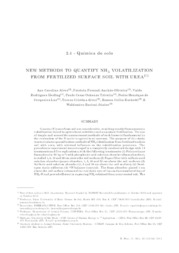New methods to quantify NH3 volatilization from fertilized surface soil with urea.
New methods to quantify NH3 volatilization from fertilized surface soil with urea.
Author(s): ALVES, A. C.; OLIVEIRA, P. P. A.; HERLING, V. R.; TREVELIN, P. C.; LUZ, P. H. DE C.; ALVES, T. C.; ROCHETTI, R. C.; BARIONI JUNIOR, W.
Summary: Gaseous N losses from soil are considerable, resulting mostly from ammonia volatilization linked to agricultural activities such as pasture fertilization. The use of simple and accessible measurement methods of such losses is fundamental in the evaluation of the N cycle in agricultural systems. The purpose of this study was to evaluate quantification methods of NH3 volatilization from fertilized surface soil with urea, with minimal influence on the volatilization processes. The greenhouse experiment was arranged in a completely randomized design with 13 treatments and five replications, with the following treatments: (1) Polyurethane foam (density 20 kg m-3) with phosphoric acid solution absorber (foam absorber), installed 1, 5, 10 and 20 cm above the soil surface; (2) Paper filter with sulfuric acid solution absorber (paper absorber, 1, 5, 10 and 20 cm above the soil surface); (3) Sulfuric acid solution absorber (1, 5 and 10 cm above the soil surface); (4) Semiopen static collector; (5) 15N balance (control). The foam absorber placed 1 cm above the soil surface estimated the real daily rate of loss and accumulated loss of NH3?N and proved efficient in capturing NH3 volatized from urea-treated soil. The estimates based on acid absorbers 1, 5 and 10 cm above the soil surface and paper absorbers 1 and 5 cm above the soil surface were only realistic for accumulated NNH3 losses. Foam absorbers can be indicated to quantify accumulated and daily rates of NH3 volatilization losses similarly to an open static chamber, making calibration equations or correction factors unnecessary.
Publication year: 2011
Types of publication: Journal article
Keywords: 15 N, Ammonia absorber, Fertilizer N, NH3 N loss
Observation
Some of Embrapa's publications are published as ePub files. To read them, use or download one of the following free software options to your computer or mobile device. Android: Google Play Books; IOS: iBooks; Windows and Linux: Calibre.
Access other publications
Access the Agricultural Research Database (BDPA) to consult Embrapa's full library collection and records.
Visit Embrapa Bookstore to purchase books and other publications sold by Embrapa.

